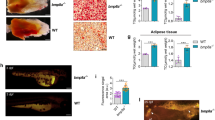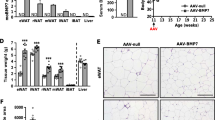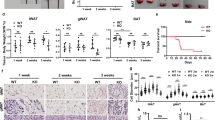Abstract
Background:
Bone morphogenetic protein-3b (BMP-3b) is a member of the transforming growth factor-β superfamily and has several activities that differ from those of other BMPs. We previously found that BMP-3b is highly expressed in adipocytes, its level is increased during obesity, and it inhibits adipogenesis by suppressing peroxisome proliferator-activated receptor γ (PPARγ) in vitro. However, the function of BMP-3b in adipose tissues in vivo remains unknown.
Methods:
To determine the role of BMP-3b overexpression in adipose tissues in vivo, we generated transgenic mice (BMP-3b Tg) by using a conditional overexpression approach in fatty acid-binding protein 4-expressing adipocytes. We examined BMP-3b Tg mice fed a high-fat diet to elucidate the effects of BMP-3b on obesity. Adipocyte function was evaluated as expression of adipogenic and lipogenic markers in adipose tissue. We also performed glucose and insulin tolerance tests (GTT and ITT, respectively), and biochemical analysis of serum and measured energy expenditure by indirect calorimetry.
Results:
BMP-3b Tg mice fed a high-fat diet showed decreases in weight gain, fat-pad mass and adipocyte area, compared with wild-type mice. The adipose tissues of BMP-3b Tg mice showed downregulated expression of PPARγ and its target gene encoding fatty acid translocase/CD36. In addition, BMP-3b Tg mice had decreased blood glucose levels on GTT and ITT, and their serum leptin levels were decreased and adiponectin concentrations were increased. These changes in BMP-3b Tg mice were accompanied by increased energy expenditure, indicated as increased locomotor activity and oxygen consumption.
Conclusions:
These results provide in vivo evidence that BMP-3b regulates adipocyte function to cause an anti-obesity effect.
This is a preview of subscription content, access via your institution
Access options
Subscribe to this journal
Receive 12 print issues and online access
$259.00 per year
only $21.58 per issue
Buy this article
- Purchase on Springer Link
- Instant access to full article PDF
Prices may be subject to local taxes which are calculated during checkout





Similar content being viewed by others

References
Karastergiou K, Mohamed-Ali V . The autocrine and paracrine roles of adipokines. Mol Cell Endocrinol 2010; 318: 69–78.
White UA, Stephens JM . Transcriptional factors that promote formation of white adipose tissue. Mol Cell Endocrinol 2010; 318: 10–14.
Lefterova MI, Lazar MA . New developments in adipogenesis. Trends Endocrinol Metab 2009; 20: 107–114.
Rosen ED, Spiegelman BM . Adipocytes as regulators of energy balance and glucose homeostasis. Nature 2006; 444: 847–853.
Ahima RS, Lazar MA . Adipokines and the peripheral and neural control of energy balance. Mol Endocrinol 2008; 22: 1023–1031.
Rosen ED, MacDougald OA . Adipocyte differentiation from the inside out. Nat Rev Mol Cell Biol 2006; 7: 885–896.
Zamani N, Brown CW . Emerging roles for the transforming growth factor-beta superfamily in regulating adiposity and energy expenditure. Endocr Rev 2011; 32: 387–403.
Schulz TJ, Tseng YH . Emerging role of bone morphogenetic proteins in adipogenesis and energy metabolism. Cytokine Growth Factor Rev 2009; 20: 523–531.
Tseng YH, Kokkotou E, Schulz TJ, Huang TL, Winnay JN, Taniguchi CM et al. New role of bone morphogenetic protein 7 in brown adipogenesis and energy expenditure. Nature 2008; 454: 1000–1004.
Takao M, Hino J, Takeshita N, Konno Y, Nishizawa T, Matsuo H et al. Identification of rat bone morphogenetic protein-3b (BMP-3b), a new member of BMP-3. Biochem Biophys Res Commun 1996; 219: 656–662.
Hino J, Takao M, Takeshita N, Konno Y, Nishizawa T, Matsuo H et al. cDNA cloning and genomic structure of human bone morphogenetic protein-3b (BMP-3b). Biochem Biophys Res Commun 1996; 223: 304–310.
Cunningham NS, Jenkins NA, Gilbert DJ, Copeland NG, Reddi AH, Lee SJ . Growth/differentiation factor-10: a new member of the transforming growth factor-beta superfamily related to bone morphogenetic protein-3. Growth Factors 1995; 12: 99–109.
Hino J, Kangawa K, Matsuo H, Nohno T, Nishimatsu S . Bone morphogenetic protein-3 family members and their biological functions. Front Biosci 2004; 9: 1520–1529.
Hino J, Nishimatsu S, Nagai T, Matsuo H, Kangawa K, Nohno T . Coordination of BMP-3b and Cerberus is required for head formation of Xenopus embryos. Dev Biol 2003; 260: 138–157.
Matsumoto Y, Otsuka F, Hino J, Miyoshi T, Takano M, Miyazato M et al. Bone morphogenetic protein-3b (BMP-3b) inhibits osteoblast differentiation via Smad2/3 pathway by counteracting Smad1/5/8 signaling. Mol Cell Endocrinol 2012; 350: 78–86.
Hino J, Miyazawa T, Miyazato M, Kangawa K . Bone morphogenetic protein-3b (BMP-3b) is expressed in adipocytes and inhibits adipogenesis as a unique complex. Int J Obes 2012; 36: 725–734.
Korsic M, Gotovac K, Nikolac M, Dusek T, Skegro M, Muck-Seler D et al. Gene expression in visceral and subcutaneous adipose tissue in overweight women. Front Biosci (Elite Ed) 2012; 4: 2834–2844.
Kawamoto S, Niwa H, Tashiro F, Sano S, Kondoh G, Takeda J et al. A novel reporter mouse strain that expresses enhanced green fluorescent protein upon Cre-mediated recombination. FEBS Lett 2000; 470: 263–268.
Nuotio-Antar AM, Poungvarin N, Li M, Schupp M, Mohammad M, Gerard S et al. FABP4-Cre mediated expression of constitutively active ChREBP protects against obesity, fatty liver, and insulin resistance. Endocrinology 2015; 156: 4020–4032.
Makowski L, Boord JB, Maeda K, Babaev VR, Uysal KT, Morgan MA et al. Lack of macrophage fatty-acid-binding protein aP2 protects mice deficient in apolipoprotein E against atherosclerosis. Nat Med 2001; 7: 699–705.
Teboul L, Febbraio M, Gaillard D, Amri EZ, Silverstein R, Grimaldi PA . Structural and functional characterization of the mouse fatty acid translocase promoter: activation during adipose differentiation. Biochem J 2001; 360: 305–312.
Rieusset J, Touri F, Michalik L, Escher P, Desvergne BA, Niesor E et al. A new selective peroxisome proliferator-activated receptor gamma antagonist with antiobesity antidiabetic activity. Mol Endocrinol 2002; 16: 2628–2644.
Coburn CT, Knapp FF, Febbraio M, Beets AL, Silverstein RL, Abumrad NA . Defective uptake and utilization of long chain fatty acids in muscle and adipose tissues of CD36 knockout mice. J Biol Chem 2000; 275: 32523–32529.
Baksh D, Song L, Tuan RS . Adult mesenchymal stem cells: characterization, differentiation, and application in cell and gene therapy. J Cell Mol Med 2004; 8: 301–316.
Yogosawa S, Izumi T . Roles of activin receptor-like kinase 7 signaling and its target, peroxisome proliferator-activated receptor gamma, in lean and obese adipocytes. Adipocyte 2013; 2: 246–250.
Kubota N, Terauchi Y, Miki H, Tamemoto H, Yamauchi T, Komeda K et al. PPAR gamma mediates high-fat diet-induced adipocyte hypertrophy and insulin resistance. Mol Cell 1999; 4: 597–609.
Olefsky J, Reaven GM, Farquhar JW . Effects of weight reduction on obesity - studies of lipid and carbohydrate metabolism in normal and hyperlipoproteinemic subjects. J Clin Invest 1974; 53: 64–76.
Acknowledgements
We thank Dr J Miyazaki for providing the pCAG-CAT-EGFP plasmid, Dr M Yoshimoto for guidance and helpful advice on indirect calorimetry, and Dr K Miura for helpful advice on western blotting. We appreciate the excellent technical assistance of Ms M Miyazaki, Ms Y Fujii and Ms M Kitazume. This work was supported in part by Grants-in-Aid for Scientific Research from the Ministry of Education, Culture, Sports, Science, and Technology of Japan; the Intramural Research Fund (27-2-2) for Cardiovascular Diseases of the National Cerebral and Cardiovascular Center of Japan; the Japan Vascular Disease Research Foundation; and the Takeda Scientific Foundation.
Author information
Authors and Affiliations
Corresponding author
Ethics declarations
Competing interests
The authors declare no conflict of interest.
Additional information
Supplementary Information accompanies this paper on International Journal of Obesity website
Rights and permissions
About this article
Cite this article
Hino, J., Nakatani, M., Arai, Y. et al. Overexpression of bone morphogenetic protein-3b (BMP-3b) in adipose tissues protects against high-fat diet-induced obesity. Int J Obes 41, 483–488 (2017). https://doi.org/10.1038/ijo.2017.15
Received:
Revised:
Accepted:
Published:
Issue Date:
DOI: https://doi.org/10.1038/ijo.2017.15
This article is cited by
-
Reduced plasma GDF10 levels are positively associated with cholesterol impairment and childhood obesity
Scientific Reports (2024)
-
Bmp8a deletion leads to obesity through regulation of lipid metabolism and adipocyte differentiation
Communications Biology (2023)
-
Endocrine role of bone in the regulation of energy metabolism
Bone Research (2021)


